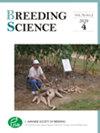尖孢镰刀菌数量性状位点(QTL)分析及精细定位萝卜的抗病性<i>采用grass - di技术
IF 2
4区 农林科学
Q2 AGRONOMY
引用次数: 0
摘要
枯萎病是萝卜的重要病害,但控制其抗黄性的遗传机制尚不清楚。本研究旨在利用抗性和易感萝卜亲本培育的F2:3群体,鉴定其中的一个yr - qtl,并对其进行精细定位。本研究利用随机扩增子测序-直接(grass - di)技术构建了2个高密度遗传图谱,每个遗传图谱均包含共有共显性标记和雌性或雄性显性标记,长度分别为988.6和1127.5 cM,平均标记密度分别为1.40和1.53 cM。我们在R2和R7染色体上鉴定了两个yr -QTL,并将后者指定为ForRs1为主要QTL。精细的定位将ForRs1基因座缩小到一个195 kb的区域。在该区的16个预测基因中,通过对亲本核苷酸序列和预测功能的比较,确定了4个基因为ForRs1的首选候选基因,其中包括两个受体样蛋白和激酶基因(RLP/RLK)。本研究首次利用grass - di构建十字花科作物遗传图谱,并精细定位萝卜R7染色体上的YR-QTL。这些发现将为萝卜YR育种和了解YR的遗传学机制提供开创性的见解。本文章由计算机程序翻译,如有差异,请以英文原文为准。
Quantitative trait locus (QTL) analysis and fine-mapping for <i>Fusarium oxysporum</i> disease resistance in <i>Raphanus sativus</i> using GRAS-Di technology
Fusarium wilt is a significant disease in radish, but the genetic mechanisms controlling yellows resistance (YR) are not well understood. This study aimed to identify YR-QTLs and to fine-map one of them using F2:3 populations developed from resistant and susceptible radish parents. In this study, two high-density genetic maps each containing shared co-dominant markers and either female or male dominant markers that spanned 988.6 and 1127.5 cM with average marker densities of 1.40 and 1.53 cM, respectively, were generated using Genotyping by Random Amplicon Sequencing-Direct (GRAS-Di) technology. We identified two YR-QTLs on chromosome R2 and R7, and designated the latter as ForRs1 as the major QTL. Fine mapping narrowed down the ForRs1 locus to a 195 kb region. Among the 16 predicted genes in the delimited region, 4 genes including two receptor-like protein and -kinase genes (RLP/RLK) were identified as prime candidates for ForRs1 based on the nucleotide sequence comparisons between the parents and their predicted functions. This study is the first to use a GRAS-Di for genetic map construction of cruciferous crops and fine map the YR-QTL on the R7 chromosome of radish. These findings will provide groundbreaking insights into radish YR breeding and understanding the genetics of YR mechanism.
求助全文
通过发布文献求助,成功后即可免费获取论文全文。
去求助
来源期刊

Breeding Science
农林科学-农艺学
CiteScore
4.90
自引率
4.20%
发文量
37
审稿时长
1.5 months
期刊介绍:
Breeding Science is published by the Japanese Society of Breeding. Breeding Science publishes research papers, notes and reviews
related to breeding. Research Papers are standard original articles.
Notes report new cultivars, breeding lines, germplasms, genetic
stocks, mapping populations, database, software, and techniques
significant and useful for breeding. Reviews summarize recent and
historical events related breeding.
Manuscripts should be submitted by corresponding author. Corresponding author must have obtained permission from all authors
prior to submission. Correspondence, proofs, and charges of excess page and color figures should be handled by the corresponding author.
 求助内容:
求助内容: 应助结果提醒方式:
应助结果提醒方式:


